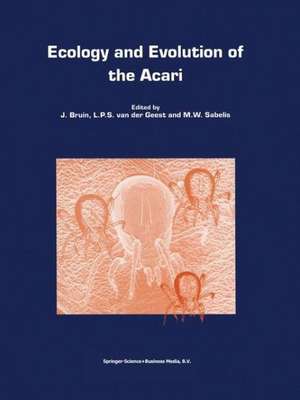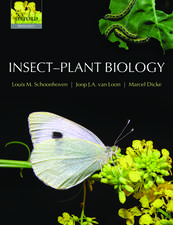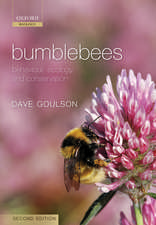Ecology and Evolution of the Acari: Proceedings of the 3rd Symposium of the European Association of Acarologists 1–5 July 1996, Amsterdam, The Netherlands: Series Entomologica, cartea 55
Editat de J. Bruin, Leo P.S. van der Geest, M. W. Sabelisen Limba Engleză Paperback – 27 ian 2011
| Toate formatele și edițiile | Preț | Express |
|---|---|---|
| Paperback (1) | 1854.48 lei 6-8 săpt. | |
| SPRINGER NETHERLANDS – 27 ian 2011 | 1854.48 lei 6-8 săpt. | |
| Hardback (1) | 1850.21 lei 6-8 săpt. | |
| SPRINGER NETHERLANDS – 31 mai 1999 | 1850.21 lei 6-8 săpt. |
Din seria Series Entomologica
-
 Preț: 393.90 lei
Preț: 393.90 lei -
 Preț: 385.25 lei
Preț: 385.25 lei -
 Preț: 414.42 lei
Preț: 414.42 lei -
 Preț: 393.90 lei
Preț: 393.90 lei - 18%
 Preț: 830.70 lei
Preț: 830.70 lei - 18%
 Preț: 1220.75 lei
Preț: 1220.75 lei - 18%
 Preț: 1841.32 lei
Preț: 1841.32 lei - 18%
 Preț: 1218.04 lei
Preț: 1218.04 lei - 18%
 Preț: 1223.25 lei
Preț: 1223.25 lei -
 Preț: 385.62 lei
Preț: 385.62 lei - 24%
 Preț: 811.88 lei
Preț: 811.88 lei -
 Preț: 351.51 lei
Preț: 351.51 lei - 18%
 Preț: 810.99 lei
Preț: 810.99 lei -
 Preț: 403.53 lei
Preț: 403.53 lei - 18%
 Preț: 936.93 lei
Preț: 936.93 lei - 15%
 Preț: 642.83 lei
Preț: 642.83 lei -
 Preț: 393.59 lei
Preț: 393.59 lei - 18%
 Preț: 1664.26 lei
Preț: 1664.26 lei - 18%
 Preț: 1217.27 lei
Preț: 1217.27 lei - 18%
 Preț: 1386.30 lei
Preț: 1386.30 lei - 18%
 Preț: 1831.27 lei
Preț: 1831.27 lei - 18%
 Preț: 951.14 lei
Preț: 951.14 lei - 18%
 Preț: 2107.18 lei
Preț: 2107.18 lei - 18%
 Preț: 1219.77 lei
Preț: 1219.77 lei - 18%
 Preț: 1832.22 lei
Preț: 1832.22 lei - 18%
 Preț: 1229.91 lei
Preț: 1229.91 lei - 18%
 Preț: 1594.64 lei
Preț: 1594.64 lei - 18%
 Preț: 1833.16 lei
Preț: 1833.16 lei - 18%
 Preț: 1392.95 lei
Preț: 1392.95 lei - 18%
 Preț: 1237.93 lei
Preț: 1237.93 lei - 18%
 Preț: 1219.31 lei
Preț: 1219.31 lei - 24%
 Preț: 1073.73 lei
Preț: 1073.73 lei -
 Preț: 389.70 lei
Preț: 389.70 lei - 18%
 Preț: 1246.15 lei
Preț: 1246.15 lei - 18%
 Preț: 1226.70 lei
Preț: 1226.70 lei - 18%
 Preț: 1225.31 lei
Preț: 1225.31 lei - 18%
 Preț: 1232.89 lei
Preț: 1232.89 lei - 18%
 Preț: 1832.22 lei
Preț: 1832.22 lei - 18%
 Preț: 1232.71 lei
Preț: 1232.71 lei - 24%
 Preț: 1604.93 lei
Preț: 1604.93 lei
Preț: 1854.48 lei
Preț vechi: 2261.56 lei
-18% Nou
Puncte Express: 2782
Preț estimativ în valută:
354.85€ • 386.67$ • 299.02£
354.85€ • 386.67$ • 299.02£
Carte tipărită la comandă
Livrare economică 23 aprilie-07 mai
Preluare comenzi: 021 569.72.76
Specificații
ISBN-13: 9789048152001
ISBN-10: 9048152003
Pagini: 692
Ilustrații: XII, 677 p. 246 illus.
Dimensiuni: 210 x 279 x 36 mm
Greutate: 1.53 kg
Ediția:Softcover reprint of hardcover 1st ed. 1999
Editura: SPRINGER NETHERLANDS
Colecția Springer
Seria Series Entomologica
Locul publicării:Dordrecht, Netherlands
ISBN-10: 9048152003
Pagini: 692
Ilustrații: XII, 677 p. 246 illus.
Dimensiuni: 210 x 279 x 36 mm
Greutate: 1.53 kg
Ediția:Softcover reprint of hardcover 1st ed. 1999
Editura: SPRINGER NETHERLANDS
Colecția Springer
Seria Series Entomologica
Locul publicării:Dordrecht, Netherlands
Public țintă
ResearchCuprins
Evolution and systematics of the Chelicerata.- Canalized pathways of change and constraints in the evolution of reproductive modes of microarthropods.- Morphological evidence for the evolutionary origin of Astigmata (Acari: Acariformes).- Evolution of phytophagy in trombidiform mites.- Origin and evolution of feather mites (Astigmata).- Phylogeny and co-speciation in feather mites of the subfamily Avenzoariinae (Analgoidea: Avenzoariidae).- Loss of larval parasitism in parasitengonine mites.- Life-history evolution in Parasitengonae (Acari: Prostigmata): constraints on number and size of offspring.- Sperm competition in the Acari.- Distribution of asymmetrical and symmetrical sperm storage in the Eriophyoidea and its phylogenetic implications.- Host plant associations in the spider mite Tetranychus urticae (Acari: Tetranychidae): insights from molecular phylogeography.- Genetic differentiation in Tetranychus urticae (Acari: Tetranychidae) from greenhouses in France.- The role of adaptation to host plants in the evolution of reproductive isolation: Negative evidence from Tetranychus urticae.- Geographic differences in host specialization between the symbiotic water mites Unionicola formosa and U. foili (Acari: Unionicolidae).- Interactions between arthropod predators and plants: A conspiracy against herbivorous arthropods?.- Behaviour and indirect interactions in food webs of plant-inhabiting arthropods.- Behavioural ecology of plant—phytoseiid interactions mediated by herbivore-induced plant volatiles.- The ecology of Lyme borreliosis vector ticks.- Biology and ecology of trombidiid mites (Acari: Trombidioidea).- Reflections on the biology, morphology and ecology of the Macrochelidae.- Phoresy by Hemisarcoptes (Acari: Hemisarcoptidae) on Chilocorus (Coleoptera:Coccinellidae): Influence of subelytral ultrastructure.- When to leave the brood chamber? Routes of dispersal in mites associated with burying beetles.- Functional morphology as an aid in determining trophic behaviour: The placement of astigmatic mites in food webs of water-filled tree hole communities.- Natural selection of Varroa jacobsoni explains the differential reproductive strategies in colonies of Apis cerana and Apis mellifera.- Regaining the water: a simulation model approach for Arrenurus larvae (Hydrachnellae) parasitizing damselflies (Coenagrion puella: Odonata).- Juvenile survival and development in Euseius finlandicus, Typhlodromus pyri and Kampimodromus aberrans (Acari: Phytoseiidae) feeding on con- and heterospecific immatures.- Do western flower thrips avoid plants infested with spider mites? Interactions between potential competitors.- Food and feeding behaviour of deutonymphs and adults of the water mite Hydrachna skorikowi (Acari: Hydrachnellae), with notes on the structure of their mouthparts.- Leaf hairs influence searching efficiency and predation rate of the predatory mite Phytoseiulus persimilis (Acari: Phytoseiidae).- Life-history parameters of two closely related forms of the Tetranychus urticae-complex on different host plants.- The contribution of extrafloral nectar to survival and reproduction of the predatory mite Iphiseius degenerans on Ricinus communis.- Pollen as a medium for rearing plant-feeding acarid mites (Acari: Acaridae).- Bionomics of Carpoglyphus lactis (Acari: Carpoglyphidae) on honey.- Mass-rearing of Amblyseius californicus (Acari: Phytoseiidae) on two alternative food sources.- The influence of various kinds of food on the distribution and life cycle of Metarhombognathus armatus (Halacaridae: Rhombognathinae).- Populationbiology of a phytophagous mite of marine and estuarine rocky shores (Astigmata, Hyadesiidae).- Diel and seasonal drift of water mites (Acari, Hydrachnidia) in two streams of the North German Lowland.- Water mites (Acari: Hydrachnidia, Halacaridae) from the hyporheic habitat of the Mugnone stream (Tuscany, Italy).- Water mites of typical habitats in four Polish national parks situated in different landscapes.- Remarks on the morphology, life cycle, distribution and taxonomy of water mites of the subfamily Acherontacarinae in the Western Palaearctic.- Water mites of small boreal forest lakes (Central Finland).- Presence of acetabula-like structures on the coxae of the neotropical water mite genus Neotyrrellia (Tyrrelliinae, Limnesiidae, Prostigmata).- Oribatid mites of the Galápagos Islands: Faunistics, ecology and speciation.- Gamasina in a succession of thirteen years.- Oribatid mites of a riverine forest in the Central Alps (Austria).- Comparison of adult oribatid mites (Acari, Oribatida) from three mountain forests in Poland: I. Abundance, biomass and species richness.- Compact aggregation and life history strategy in a continental Antarctic mite.- A biometrical study of Berniniella serratirostris (Acari: Oribatei) and some related species.- Morphological variability in populations of a thelytokous mite, Trhypochthoniellus longisetus (Oribatida), with notes on synonymy.- Fine structure of the humeral organ of juvenile Edwardzetes edwardsii (Ceratozetidae, Oribatida).- Observations on the fine structure of the vagina of pergamasid mites (Pergamasidae, Parasitina, Gamasida).- Ultrastructural cell modification in tomato (Lycopersicon esculentum) leaf tissue in response to the carmine spider mite (Tetranychus cinnabarinus) feeding.- Influence of soil management on mitepopulations in a vineyard agroecosystem.- Overwintering of phytoseiid mites (Parasitiformes, Phytoseiidae) on hazelnut (Corylus avellana) in Sicily (Italy).- Prosomal glands in Typhlodromus spp. females (Mesostigmata: Phytoseiidae).- Allergenic mites associated with bird nests in Poland (Astigmata: Pyroglyphidae, Acaridae, Glycyphagidae).- Body weight characteristics of some ixodid ticks: Reflecting adaptations to conditions of their habitats?.- Species validity of the soft-tick Argas polonicus (Acari: Argasidae) based on 16S rDNA sequence analysis.














